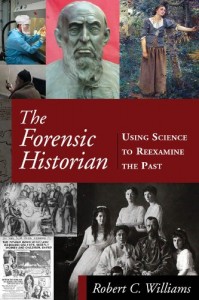Book by Williams ’60 Studies History and Forensic Analysis

In his new book, The Forensic Historian: Using Science to Reexamine the Past (M. E. Sharpe), Robert Williams ’60 demonstrates how seemingly cold cases from history have been solved or had new light shed on them by scientists and historians using new forensic evidence. He provides examples ranging in time from Oetzi the Iceman—who died 5,300 years ago in the Swiss Alps from an arrow wound, yet is known to have had brown eyes Lyme disease, type-O blood, an intolerance to lactose, cavities, and tattoos—to the process of identifying Osama Bin Laden’s body in 2011.

“Since World War II, forensic pathology and anthropology have slowly given way to genetics and DNA ‘fingerprinting,’ along with computer hardware and software, as scientific evidence that can stand up in court,” Williams comments in his introduction. “This book highlights that transition through specific case studies showing how modern forensic historians and scientists do their work and what kinds of evidence they must obtain.”
Samples of Beethoven’s hair and bones were found to have abnormally high levels of lead, suggesting he may have died from lead poisoning. The Shroud of Turin was carbon-dated back to the 14th century, not the 1st. The Titanic was found to have been assembled using low-quality rivets that almost certainly played a part in its sinking in 1912. These high-profile cases continue to hold the public’s fascination, and Williams provides a concise synopsis of the methods used to reach conclusions for each. Be forewarned, however, that what you hear in the news relating to cases like these will not always convey the hard science correctly.
“The media cannot wait patiently until forensic historians and scientists finish their plodding work,” writes Williams. “Thus the media often rush to create a virtual reality that encourages forensic historians to publicize their findings prematurely, often without peer review.”
Williams retired in the spring of 2003 as Vail Professor of History at Davidson College, where he served for 13 years as vice president for academic affairs and dean of the faculty. He is the author of the best-selling Historian’s Toolbox and of numerous articles and books on Russian history, including Ruling Russian Eurasia: Khans, Clans, and Tsars; Russian Art and American Money, 1900–1940 (nominated by Harvard University Press for the Pulitzer Prize); Klaus Fuchs: Atom Spy; and Russia Imagined: Art, Culture, and National Identity, 1840–1995.

